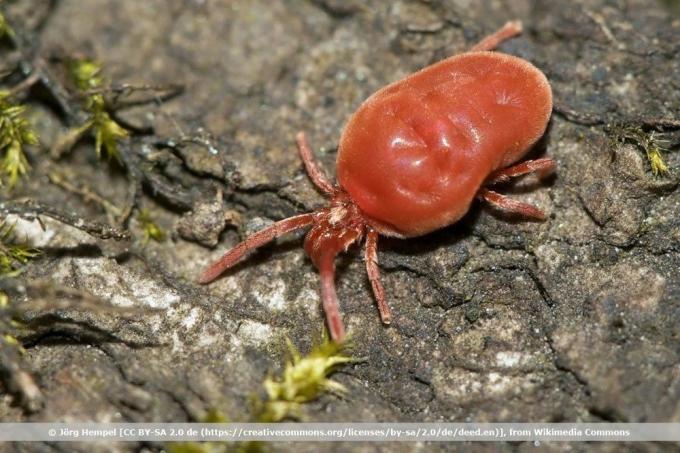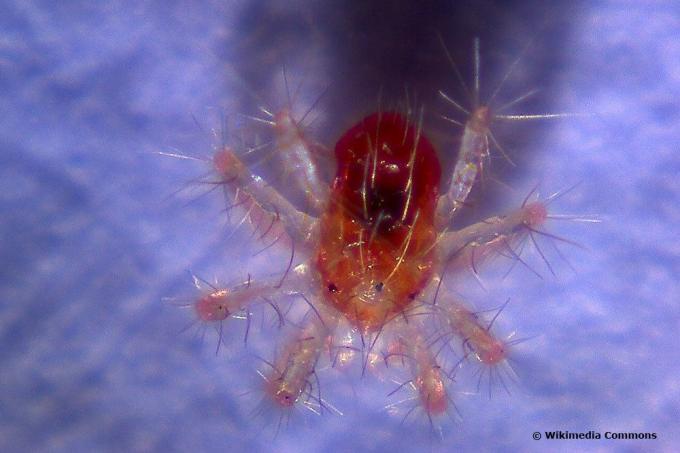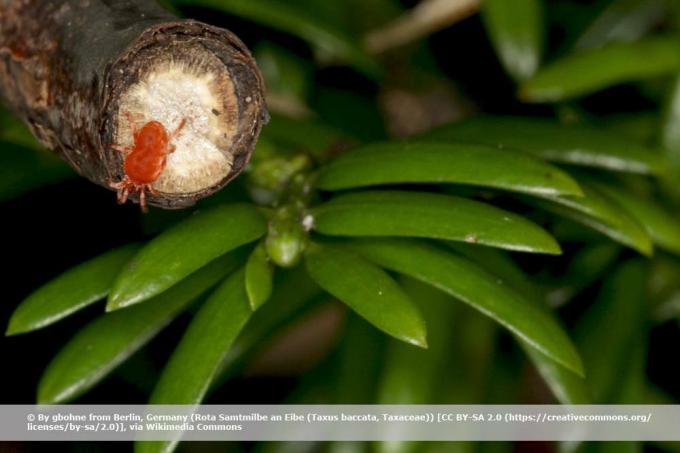
table of contents
- Red spiders
- Fruit tree spider mite
- Red velvet mite
- Prevent
- Fight
- Wrong recommendations
It tingles here, it crawls there - by the warm season at the latest, all kinds of animals can be found in the garden again. Small, red spiders, more precisely mostly red velvet mites, are part of it. You can find out which other red spiders there are and what to do against the red velvet mite here.
Red spiders
When small red spiders are spotted, it is usually one of the following two species:
- Fruit tree spider mite (Panonychus ulmi)
- red velvet mite (Trombidium holosericeum)
Fruit tree spider mite
The fruit tree spider mite is one of the pests. As the name suggests, it does its job especially in fruit growing. Apple trees in particular are among her favorite foods. The red spider mites suck the sap from the flowers and leaves, which can lead to reduced budding and ultimately to the lack of harvest in the following years.
Appearance
You can recognize the fruit tree spider mite by the following characteristics:
- oval, domed and red-brown body
- long bristles and pale warts
- Females up to 0.4 mm long, males slightly smaller
- yellow-green to light red larvae

Damage image
The small, red insects lay their eggs near plants, they are small and red-haired. The effect on the budding of the plant becomes noticeable after a few weeks, the leaves change color and turn reddish-brown. Most of the time, however, you have already discovered that your plant is infested with fruit tree spider mites.
- bright spots on the leaves
- are getting more and more yellow
- Eggs, larvae and adults mainly on the underside of the leaves
- thin webs on the plant
- Leaves dry up and fall off
Red velvet mite
The red velvet mite is one of the running mites. Although mites, such as spider mites, are often pests, Trombidium holosericeum is one of the beneficials. Because instead of attacking humans, animals or plants, the velvet mite attacks all kinds of insects and pests. She sucks out their eggs and "cleans" our gardens.
It is relatively easy to spot a red velvet mite:
- up to 4 mm long
- thick, scarlet hair, velvety
- small, stalked eyes
- scissor-shaped jaw claws
- long front legs
- prefers dry, warm surroundings
- often on terraces and walls
Attention: Do not confuse the red velvet bilbe with female ticks, but these are about ten times the size.
The normal life cycle of a velvet mite is that it is active and busy in summer, but remains in the ground in winter and slows down its metabolism. However, if the temperatures are not cold enough for this - in the apartment, for example - the metabolism remains active and food is constantly required.
Prevent
Increase humidity
If the humidity is too high, there is the best climate for the small, red spiders. It is therefore an advantage if the humidity in your home is kept low. Special dehumidifiers can help.
Insect screens
So that the little red spiders do not even get into your living space, equip windows and doors with fine-meshed insect screens or nets. These are available in different designs and are usually very easy to attach.

Fight
The little red spiders are welcome guests in the garden. But they like to collect on terraces and house walls and then quickly get into our living area. And there we want to get rid of the red velvet mite quickly.
How are red spider mites controlled?
There are several tips and tricks you can use to successfully fight the small, red spiders. When you have spotted a few specimens on your plants, it is time to decimate them. You do this in several steps.
Shower off
The first step is to give the plant a thorough shower to remove cobwebs and active mites. However, since the animals are useful for our garden, we would advise against killing them. Bring the plant outdoors and gently shower it there with the hose.
Plant-dependent maintenance measures
Depending on the plant, you can stop the mite infestation by radical pruning. It also makes sense to replace the soil and rinse off the entire roots.

Note: However, if the little red spiders take over and besiege your home, consider an exterminator.
Wrong recommendations
The internet forums are full of exciting tips and tricks on how to get rid of red velvet mites. However, many of them are anything but healthy for your plants and deadly for beneficial insects. You should steer clear of these methods below.
- Pull an airtight plastic bag over the plant
- Shower with soapy water or alcohol
- Neem oil for cleaning
- Spray with a high oil content
- Plant protection products for the interior




